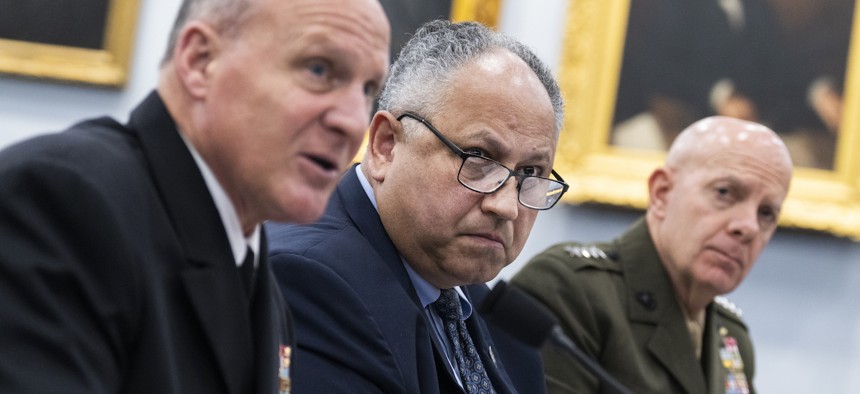
Adm. Michael M. Gilday, chief of naval operations, Secretary of the Navy Carlos Del Torro, and Marine Corps Commandant Gen. David H. Berger, testify during a hearing in 2022. Tom Williams/CQ-Roll Call, Inc via Getty Images
Navy, Marines Reevaluating Munition Stockpiles Due To Ukraine War
“Ukraine's war has taught us that we must transition from just-in-time stockpiles of weapons and munitions to just-in-case stockpiles,” Sen. Collins said.
The rate at which Ukrainians are firing munitions at Russian invaders has led the U.S. Navy and Marine Corps to reevaluate the levels of munitions they need to stockpile for a future conflict, service officials said Tuesday.
“I think the biggest thing we learned was the expenditure rates. It's caused us to go back, to take a look at our own wargaming and analysis, what our predicted expenditure rates would be, and the questions and assumptions we made. So that's why, for the Navy and Marine Corps, you see four multi-year procurements of weapons in this budget proposal,” Chief of Naval Operations Adm. Mike Gilday told lawmakers during a hearing of the Senate Appropriations defense subcommittee.
The Navy had expected expenditure rates to be lower because weapons are now more technologically advanced, Gilday said.
“That's not playing out so well in Ukraine. So, it's informed our thinking,” he said.
Marine Corps Commandant Gen. David Berger told senators the war is a “good reminder” that conflicts can last more than a few days, and therefore can require more munitions.
“It's very clear that our stockpiles for training and for warfighting, we need to reassess the assumptions in those to make sure that we have the depth. Because…our industrial base…can't be just in time if we have to go to a conflict. We’ve got to have it just in case—we’ve got to have the depth in that industrial base to account for a big surge,” he said.
The United States has provided tens of thousands of munitions and several weapon systems in security assistance packages to Ukraine since the war began, including 155mm artillery rounds and Stinger and Javelin missiles. The rate of deliveries has helped Ukraine stay in the fight, but has also depleted U.S. stockpiles. The Pentagon is now working with defense companies to help expand and increase production of weapons and munitions.
Because the Navy has “expended a lot of the munitions that we do have” to support Ukraine, and have promised to keep providing support, Navy Secretary Carlos Del Toro said the U.S. must “make a commitment to increasing munitions across the board.”
Sen. Susan Collins, R-Maine, the ranking member of the subcommittee and vice chair of the Senate Appropriations Committee, praised the Navy’s “record number” of multi-year procurement contracts for munitions this year.
“Ukraine's war has taught us that we must transition from just-in-time stockpiles of weapons and munitions to just-in-case stockpiles,” Collins said. “If implemented well, these multi-year contracts will provide industry with the certainty necessary to make that transition a reality, and deliver cost savings for the taxpayers at the same time. And help with workforce challenges.”
Del Toro, Gilday, and Berger did not elaborate on how much bigger the stockpiles should be now compared to previous levels.




